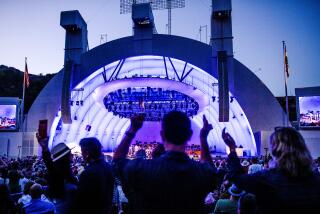L.A. considers bold makeover for Hollywood Boulevard: Fewer cars, bike lanes, wider sidewalks
Though its terrazzo sidewalks and bronze inlaid stars show off the glitz of Los Angeles to the world, the Hollywood Walk of Fame often feels decidedly short on glamour of its own.
That may change under a new makeover proposed for the iconic boulevard.
Los Angeles City Councilman Mitch O’Farrell unveiled a 90-page concept Thursday aimed at creating a less gritty, more welcoming atmosphere for the millions of tourists who visit the Walk of Fame each year.
The initial proposal draws inspiration from world-class streets across the world, including the Avenue des Champs-Elysees in Paris. That could be achieved in Hollywood, too, the plan says, with wider sidewalks, more shade trees, more space for sidewalk dining — and far less space for drivers.
“The boulevard hasn’t reached its full potential — not by a long shot,” said O’Farrell, whose district includes Hollywood. “We’re very optimistic that we can see real change on this historic boulevard within a number of years.”
If approved, the proposal would narrow Hollywood Boulevard to a center turn lane and one travel lane in each direction roughly between La Brea Avenue and Vine Street. The changes would be among the biggest yet for a major street in Los Angeles, where taking space from drivers has sparked outcry.
Eliminating a vehicle travel lane and a parking lane in each direction would create enough space to widen the sidewalks along the Walk of Fame to 25 feet on each side. The city could also add a protected lane for bicyclists and scooters, the proposal said.
That type of lane reduction has been controversial in Los Angeles, including in Playa del Rey, where the elimination of a traffic lane in 2017 sparked a massive outcry and a failed recall attempt against Councilman Mike Bonin.
Removing traffic lanes would require a careful strategy and extensive outreach, O’Farrell said. He added that business owners and residents in Hollywood have seemed open to the “road diet,” as lane reductions are often called.
“We can’t just suddenly say, ‘OK, road diet coming!’ and call it a day,” O’Farrell said. “We’ve seen what that has done on the Westside, and we know it can backfire very badly.”
O’Farrell said it would be “premature” to endorse any specific proposal before his office received more public input. Officials would pursue “revisions and fine-tuning” to the plan, and more funding, before construction could begin, he said.
The plan sparked some early concern among tour bus operators, who said reducing travel lanes could increase congestion for the bus and van drivers who drive the boulevard.
“It has the potential to be a mess,” said Jeff Napshin, the owner of Star Track Tours, one of roughly two dozen companies that operate on the boulevard.
The Art Deco theme that the document proposes would help the Walk of Fame feel more cohesive, Napshin said. But he said he was concerned that more traffic jams, or new restrictions on where tour bus companies can pick up and drop off, could hurt business.
“We want to drive up and down and give people that view,” Napshin said. “You feel like you’re the star of the show, seeing the Dolby Theatre and the El Capitan and the Chinese Theatre up close.”
Gregg Donovan, who can greet tourists in 100 languages as a guide for his company LA City Tours, said expanding the Walk of Fame sidewalks would make the often congested street safer. Tourists have been known to trip and fall on the crowded paths, he said, and drivers have hit pedestrians in the street.
Donovan said the changes probably wouldn’t lead to a drop in business, because, he said, “people will never stop taking tours.”
Large swaths of the boulevard are included on L.A.’s high-injury network, the 6% of city streets that account for the majority of fatal traffic crashes involving pedestrians and bicyclists. The changes, O’Farrell said, would make the street “much safer.”
The street’s two biggest intersections, at Vine and at Highland Avenue, have “scramble” crosswalks that allow pedestrians to cross in all directions at once. The concept document proposes more of those crosswalks. It also suggests adding slightly raised paving, similar to a speed bump, at 12 intersections to slow drivers at crosswalks.
On their second day in Los Angeles, Austrian tourists Clemens Androschin and Johanna Salzgeber walked from the Hollywood sign to Hollywood and Highland. They said they were hoping to see as much as possible on foot and on transit, as they do at home.
One of the most famous shopping and architecture streets in Vienna, called Kärntner Strasse, has been pedestrian-only since the 1970s. To soak in the atmosphere and see some of Vienna’s most famous buildings up close, tourists have to park and walk, or use public transit.
“It’s better and healthy,” said Androschin, 23, who is a student in Pittsburgh. “If you’re driving in a car, you can’t catch the tourist feeling.”
Wider sidewalks could make space for more formal amenities for tourists, the concept document said. That could include simple stages for street performers, play areas for children and dogs, kiosks for licensed vendors and outdoor restaurant seating.
The document also floats the idea of “flexible event plazas,” or areas that could be blocked off from vehicle traffic with removable metal posts called bollards. The tactic is commonly used in Europe but rarely in Los Angeles.
Hollywood Boulevard is already regularly closed for movie premieres and awards season events, so transforming more of the street into a pedestrian area wouldn’t help or harm businesses, said Mary Hom, who works at the Hollywood Experience store near El Capitan Theatre.
Parts of the Walk of Fame sidewalk were closed Thursday in preparation for a movie premiere and for the Oscars, forcing people to walk in the street.
“If people want what they want, they’ll walk to it,” Hom said as she rang up a customer’s souvenir purchase.
Street performer Antoine Baynes, dressed as Michael Jackson, had made about $15 in tips after 20 minutes of dancing outside the TCL Chinese Theatre. The former Cirque du Soleil dancer said that after two years in Los Angeles, he wasn’t impressed by the Walk of Fame.
“Hollywood shouldn’t be second to Vegas,” Baynes said. “When people come here, they need to see things that’ll blow them away.”
The plan has about $4.1 million secured, some of which paid for the document released Thursday, O’Farrell’s office said.
The Hollywood proposal comes two days after San Francisco banned cars from one of the busiest streets in the city.
The 1.9-mile stretch of Market Street through downtown is now exclusively for transit vehicles, taxis, paratransit and people on foot, bicycles and scooters. Traffic on Market had gradually filtered out over a decade as officials added more restrictions and detours.
More to Read
Start your day right
Sign up for Essential California for news, features and recommendations from the L.A. Times and beyond in your inbox six days a week.
You may occasionally receive promotional content from the Los Angeles Times.








